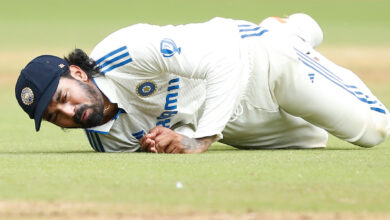The runners changing course on uniform expectations

Nell Gallogly
In eighth grade, Katelyn Hutchinson, a runner from the University of Kentucky, learned the power of a uniform.
Her coach had designed a racing kit that made the middle school team feel “comfortable and cool,” Hutchinson said. The experience left a strong impression: Uniforms can make athletes feel like themselves.
It was the last time that Hutchinson remembers feeling at ease in a race day kit. high school, “everything was skintight.”
Uniforms for women grow smaller and tighter as they ascend from high school to college to professional running, while men’s uniforms typically remain suspended in the high-school look: a loose jersey and flowing shorts or knee-length spandex for sprinters.
A growing number of amateur and elite runners are challenging these norms through dress and dialogue. Many profess a straightforward conviction: You run best when you are comfortable.
They have inspired a domino effect, allowing more runners to feel comfortable pushing what have been uniform standards. Top-tier brands are taking note: “One-size-fits-all doesn’t work for this sport,” said Jordana Katcher, the vice president of Nike women’s global sport apparel.
But the differences between men’s and women’s norms weren’t initially etched into the sport’s tradition. In 1928, when women were first permitted to compete in track and field at the Olympics, they donned uniforms closely resembling the men’s teams’ kits.
the 1980s and 1990s, athletic apparel companies began to incorporate new textile technology, including spandex, with the aim of performance advantages. To this day, companies chase uniform designs that can provide athletes with “milliseconds of time gains on their competition,” Katcher said.
As athletes adopted the tighter style, men’s and women’s aesthetics continued to diverge. A women’s typical racing kit became buns (also known as briefs or bundies) and a tight spandex top — a bathing suit, more or less.
The governing bodies for track and field at the collegiate and professional levels in the U.S. do not dictate a difference between men’s and women’s dress. And the divergence wasn’t because of effectiveness. If it had been, the world’s best runners, like marathon world record holders Eliud Kipchoge and Brigid Kosgei, would have indinguishable race day uniforms. That’s not the case.
One explanation may be rooted in the fear that sports were “masculinizing women,” said Susan Cahn, a horian and author of a book on gender and sexuality in sports. Outfitting women in smaller uniforms was intended to ameliorate this concern, framing them “to look more feminine and sexy.”
For some people, particularly media commentators, there is a sense that “the uniform gives permission to comment on athletes’ bodies because they are so on display,” said Paula Quatromoni, an associate professor of nutrition at Boston University. “That is really, really dangerous.”
Still, some athletes have found liberation in minimal outfits. Black women have often turned track uniforms “into a performance of their femininity,” according to Theresa Runstedtler, a scholar of African American hory.
She cites Florence Griffith Joyner, a three-time gold medal, as an early leader. Through her famous one-legged racing suits, hairstyles and bold use of color, Joyner “pushed back against narrow ideas of femininity that are bound notions of respectability,” Runstedtler said.
The association between smaller, tighter uniforms and success can still be a double-edged sword for many, invoking both power and discomfort. The typical women’s racing kit made Hutchinson feel like a part of an elite group, she said, but it has also made her feel uncomfortable.
Lauren Fleshman, the U.S. national champion dance runner, described women’s buns as “a badge of honor.” It was a feeling echoed more than a dozen collegiate and professional runners interviewed The New York Times.
When Fleshman optimized for comfort — replacing buns with shorts — she feared making “the least professional choice,” she said.
Slowly, athletes are beginning to adopt uniforms oriented around comfort instead of expectations. Professional runner Elly Henes saw this in her time at North Carolina State. During her freshman year, all 22 team members ran in buns; her senior year, several women had opted for spandex or shorts.
And following in Joyner’s footsteps, many are finding new athletic highs.
In February, Marquis Dendy, a professional runner and long-jump star, claimed a World Indoor Tour victory wearing a bucket hat and a balaclava.
That same month, Nikki Hiltz, a trans athlete who competes in women’s races, won the 2023 USATF Indoor 1500-meter title in split shorts and a loose jersey.
Before racing in the Javelina Jundred 100-mile race, Ryan Montgomery, a professional trail runner who is queer and who said he has often expressed his femininity aesthetically, took a pair of scissors to his jersey. “When I wear something that most reflects me, I feel empowered to run my best,” he said.
Donning a flowing crop top, Montgomery finished second.
This article originally appeared in The New York Times.







